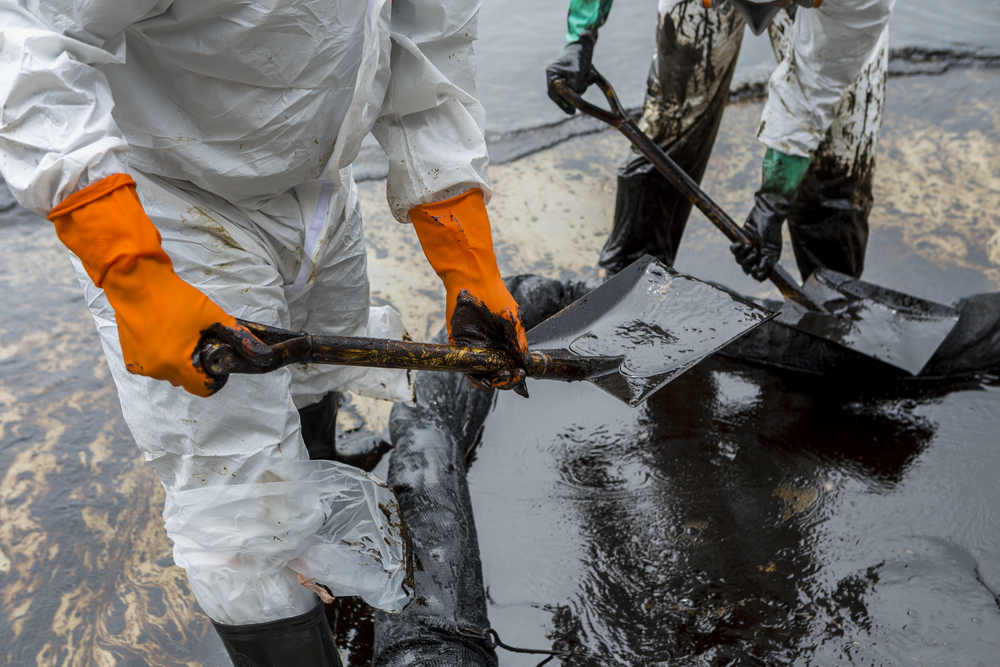Back to Basics is a weekly feature that highlights important but possibly overlooked information that any EHS professional should know. This week, we examine oil spills and OSHA’s recommendations for preparedness.
Oil spill emergencies pose great threats to both the safety of workers and the environment. According to OSHA, employers are responsible for protecting workers from the anticipated hazards associated with responding to oil spill emergencies and participation in recovery operations.
General information
An oil discharge, or spill, is defined by OSHA as the release of a liquid petroleum hydrocarbon into the environment, and it is a form of pollution. The National Contingency Plan (NCP), which is the federal government’s blueprint for responding to oil discharges and releases of hazardous substances, defines oil discharge as any spilling, leaking, pumping, pouring, emitting, emptying, or dumping of oil, and generally excludes discharges that require compliance with certain permits. Oil discharge also means substantial threat of discharge. The NCP defines oil as any kind of oil in any form, including petroleum, fuel stage oil, sludge, oil refuse, and oil mixed with wastes but not dredged spoil.
Actions taken in response to oil spills, such as stopping the oil spill or containing the spilled oil, are considered “emergency response” activities under OSHA’s Hazardous Waste Operations and Emergency Response (HAZWOPER) standard. Oil spill cleanup sites may be considered or may become hazardous waste sites and must follow the HAZWOPER requirements for hazardous waste sites.
Be prepared
Even though general workers may not be involved in oil spill cleanup, all employers and their workers should be prepared for emergency situations. According to OSHA, industries that might be affected by oil spills include:
- Commercial fishing, shrimp, and shellfish industries
- Tourism
- Facilities and operations at shipyards, ocean ports, and inland harbors
- Facilities and operations near petroleum processing or storage facilities
- Businesses near oil pipelines
If an oil spill emergency occurs near a workplace, potential hazards to workers and others at the worksite or facility during or after an oil spill include a flammable atmosphere, toxic aromatic compounds, hydrogen sulfide, and physical hazards like slips, trips, falls, and drowning.
Employers must be prepared to immediately protect workers from safety or health hazards at industries and businesses near an oil spill emergency. Workers must avoid any contact with the oil spill or any oil-contaminated surfaces and environments.
Employers should prevent employees and others without proper HAZWOPER training from conducting any kind of oil spill emergency response or recovery operations. They should listen for instructions from emergency response officials, including sheltering-in-place or evacuation procedures.
To properly protect workers, employers with facilities or operations that might be affected by oil spill hazards should consider developing an appropriate Emergency Action Plan (EAP) that contains procedures for relevant worker training.
Employers and workers must have the necessary equipment, know where to go, and know how to stay safe and healthy in the event of an oil spill emergency, says OSHA. Oil spill response, recovery, and cleanup workers must have an awareness of the common hazards caused by oil spill emergencies, and all workers with an identified role in a response organization should receive appropriate training.
Responding to spills
Oil spills can pose safety and health hazards for workers in the impacted environment. Workers whose job sites are at or near an oil spill are likely to be among the victims of an incident, and they may need to shelter in place or evacuate to safety.
OSHA states that response, cleanup, and recovery workers, specifically oil spill emergency response workers who are trying to stop or contain the discharge of oil, may be at particularly high risk for exposure to health and safety hazards, including the following:
- Fires
- Oxygen deficiency
- Carcinogens
- Chemical hazards
- Heat and cold stress
- Heavy equipment hazards
Oil spill response, recovery, and cleanup workers must have a variety of personal protective equipment (PPE). Administrative and engineering controls should be used first to minimize the need for PPE, but where those controls will not effectively minimize the exposures, PPE will be necessary.
Crude oil, its constituents, and oil dispersants can cause skin irritation and inflammation, so OSHA recommends avoiding all unprotected skin and eye contact with crude oil, dispersants, and other chemicals used during spill emergencies.
PPE to prevent skin contact should be selected carefully for use in a hot, wet environment. Skin damage due to chaffing from increased sweating can compromise the skin’s natural barrier against bacteria, especially when paired with the mechanical stress of ill-fitting PPE. Employers should have workers use sunscreen and wide-brimmed hats in this kind of environment as well. In terms of eye and face protection, shaded safety glasses, safety goggles, and face shields might be required depending on the performed tasks.
Gloves, protective clothing, and protective footwear will be necessary for many oil spill response tasks. There are several types of material capable of protecting against crude oil, including those made with neoprene, nitrile, and butyl rubber, as well as other commercially available products. Employers can evaluate PPE before purchase and use by contacting the manufacturer to make sure it has barrier performance against the expected oil spill exposures.
For more information on OSHA’s recommendations and procedures for oil spills, click here.

